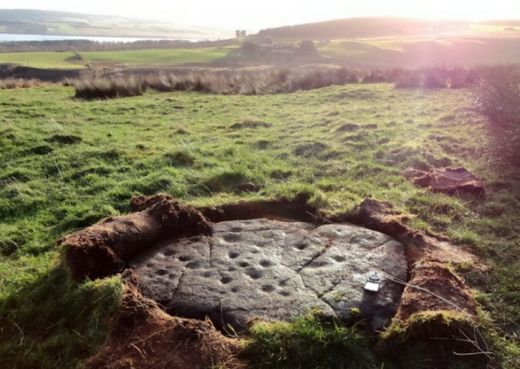
A retired silversmith has uncovered the largest collection of ancient rock art ever found in the Highlands on a remote hill overlooking the Cromarty Firth.
The carved rocks - some almost 10ft across - have been discovered scattered across a hillside near Evanton, in Ross-shire.
Douglas Scott, the amateur archaeologist who has recorded the remarkable find, believes the "cup-marked" rocks - dating from up to 5,000 years ago to the Neolithic or Bronze Age - form part of a "ritual centre of some significance" where ancient people worshipped the sun and performed rites connected to the underworld.
Mr Scott, 64, from Tain, has found and recorded a total of 28 carved rocks on Swordale Hill - Druim Mor in Gaelic - and lodged his remarkable discovery with the Highland Historic Environment Record and the Royal Commission on Ancient Monuments.
He explained yesterday that farmers had first found a small number of the carved stones, with hollow cup-marks carved into them, in 1985. A year later, he and and Bob Gourlay, then the Highland regional archaeologist, scoured Swordale Hill and recorded and photographed another 14 cup-marked rocks on the ridge.
Mr Gourlay has since died and over the past two years, Mr Scott, has completed the task of searching the entire hilltop and has now photographed and recorded 28 carved rocks across the site.
He said: "The finding of up to 28 cup-marked rocks on Druim Mor makes this the largest concentration of cup-marked stones so far found in the north of Scotland. Cup-marked stones are not unique but this is the biggest concentration found in this area and that is quite significant in itself because no-one knew these monuments were up there."
Mr Scott added: "The carvings on the rocks are anywhere between 4,000 and 5,000 years old and comprise hollows, some surrounded by rings, and grooves which all line up to where the sun rises in midwinter. There is a concentration of them, spread across 150 metres."
There is also a chambered burial cairn and a circular ditch, possible evidence of an ancient henge, on the hill.
Mr Scott added: "From the ridge, there are wide views across the fertile lands of the Cromarty Firth, the Black Isle and the distant Cairngorms. According to Gaelic folklore, these ancient people believed that the sun was rising and setting in the underworld.
"They would carve these cup marks into the rock at the times when the sun was coming up, out of what they believed was the underworld."
He said cup marks can be found throughout Europe, where they are associated with carvings of the sun, solar chariots and boats - the latter believed to carry souls of the dead to the underworld.
Mr Scott said: "The position of the cup marks, between the passage cairn and the henge, suggests that this was one of the most important ritual sites in the area."



That shows more images of British rock art that has been discovered
[Link]
This image from the site called hands and feet struck me as not hands and feet, could it be a representation of comet tails. The approximate date of the rock the art is 5000 + years ago according to the website
[Link]